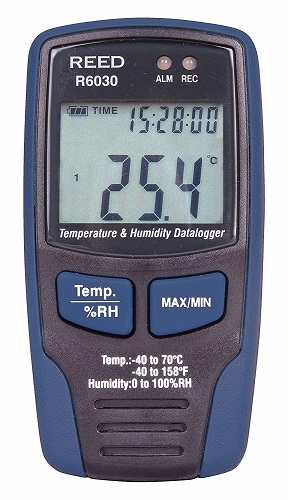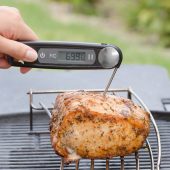In many industries, it is important to know the temperature that a product has been exposed to, and the duration. Whether heating foods before canning or sterilising medical devices, there should always be evidence of time and temperature. No matter what industry you are working on, it is always important to check and control the right level of temperature as required. That’s why data loggers are widely used for a variety of applications in almost every profession. However, not every temperature data loggers are made equal, and with so many options available these days, it might be a challenge to choose the right one for your needs. Whether you are a novice or professional user, this guide will show you essential info to make an informed decision.
What Is A Temperature Data Logger?
A temperature data logger is basically a type of data logger which is configured or optimized for temperature sensors or probes. In some cases, humidity and CO2 can also be integrated to record data of these parameters. It is able to collect and store a number of readings at a specific interval. Often powered by batteries, this device can accept one or even more sensor inputs, depending on the requirements. When the acquisition period ends, data could be download into a personal computer for later analysis. Some advanced models can even send the measurement results to a computer or other devices, thus removing the need for a field visit.
There are many types of temperature data logger, which are different in terms of designs, sensors, transmitting methods, and other features. These include:
- Modular temperature data logger
- Handheld multi-channel temperature data logger
- Fixed mount multi-channel temperature data logger
- Bluetooth temperature data logger
- Miniature single-input temperature data logger
Why do we need to purchase buy a temperature data logger?
Temperature is one of the most commonly measured and recorded parameters in many industries. Thus, temperature data loggers are used for many applications in different industries.
1) High-temperature applications
High-temperature conditions such as material and food processing, pasteurisation, or autoclaves require strict control of temperature to prevent sensitive electronics from being damaged or ensure the products reach the right temperature. For example, food canning process should record temperature data to show the evidence that products have reached the minimum temperature to eliminate organisms.
2) Water temperature
Aquariums would benefit from recording water temperature to ensure a healthy and stable environment for fish, which would survive only in specific ranges. Similarly, scientists can access the health of streams or rivers based on water temperature records.
3) Cold chain
In pharmaceutical and food industries, goods should be transported under rigorously controlled conditions to prevent spoilage. Thus, the installation of a temperature data logger would record the conditions to guarantee the integrity and provide evidence for any mishandling claim.
4) Artwork maintenance
Another application of time-stamped temperature record is the transportation and maintenance of artworks. By keep track of the temperature and humidity of the surrounding environment, museums or transportation services can ensure careful treatment.
What To Look For When Buying A Temperature Data Logger?
Here are a few parameters that you should take into consideration to narrow down your shopping list when purchasing a temperature data logger:
a) Speed and memory
Compared to data acquisition systems, temperature data loggers often have lower sampling rates mainly because they record and store data in limited internal memory. Based on your needs and applications, it is necessary to consider the sampling rate and sampling duration to choose a model with the right memory. For instance, if you need to collect readings with a rate of 2 each second and the session should last 2 hours, the device should be able to record 14,400 readings (2 hours x 3600 seconds/hour x 2 samples/second).
b) Data retrieval
Most temperature data loggers use a flash stick or memory card to record the data. Other advanced units allow users to access and download readings directly from their computer via an Ethernet or Wi-Fi connection. The final decision should be based on the connection setup of the facility, as well as the applications.
c) Software
These days, most temperature data loggers come with analysis and data graphing software packages which allow users to get started easily. You need to choose those units that are highly intuitive to minimise the learning curve. Also, make sure these applications are compatible with your computer’s operating system.
d) Price
There are many factors determining the cost of a temperature data logger, including the sample rate, configurability, or functionality. The price might range from less than £ 50 for a simple single-channel device to around £ 800 for a mixed input unit. Some loggers with advanced features like wireless connection or high-speed vibration might cost up to £ 2000-£ 50000. Thus, make sure to find the right option which fits your needs and budget.
Main brands of temperature data logger:
i. Extech
Extech is a part of Flir – one of the largest manufacturer of test and measurement devices. It is well-known for providing high-quality and innovative tools that are used in more than 100 countries.
ii. Testo
Based in Germany, Testo is a world leader in the field of stationary and portable measurement tools. Its advanced technology has more than 650,000 customers who are using their innovative solutions and precise instruments.
iii. Reed Instruments
Reed Instruments have been manufacturing quality measurement and precision test instruments since 2004. Their devices are widely used by safety & health professionals, electricians, HVAC contractors, quality control departments, and industrial maintenance teams. All of their products are supported by 5 calibration laboratories and backed by a 1-year warranty.
Top 5 Best Temperature Data Loggers
1. Reed R6030 Temperature Data Logger Review
The Reed R6030 data logger can record up to 32,700 relative humidity and ambient temperature readings. It features an adjustable recording interval for the user, ranging from 1 second to 24 hours. With a large LCD display, you can clearly see all of the current readings. The device also comes with a min/max function which will alert you when the temperature or humidity level reaches or drops to a specific amount. Its real-time clock can store time and date for better search in the future. The package includes a USB cable so that you can directly download data to your PC.
Technical features:
- Humidity range: 0% to 100%
- Temperature range: – 400C to 700C
- Record: 32,700 readings
- Recording interval: 1 seconds to 24 hours
2. Extech SD500 Temperature and Humidity Data Logger Review
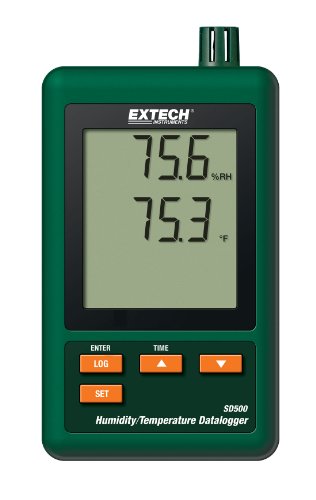
The SD500 data logger includes a 2GB SD card, which can be used to record data on humidity and temperature. The recorded info is available in xls or xlsx format to ensure that you can transfer it easily to a personal computer or laptop for analysis. The device is also designed with a dual LCD which can display temperature and relative humidity at the same time. You can choose from a variety of data recording rate to meet your requirements. These include 5s, 10s, 30s, 1m, 2m, 5m, 10m, or auto.
Technical features:
- Dual LCD display
- Data format: xls, xlsx
- Record: 2GB
- Recording interval: 5s, 10s, 30s, 1m, 2m, 5m, 10m, or auto
3. Testo H1 184 Humidity and Temperature Data Logger Review
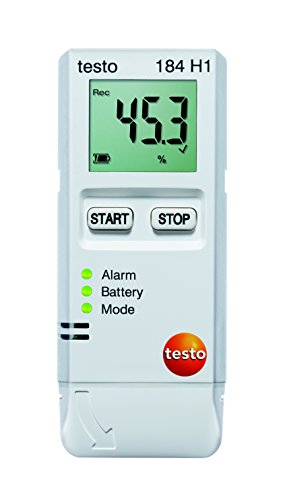
With the H1 184 humidity and temperature data logger by Testo, you can monitor the transport of many sensitive goods like pharmaceuticals, art, electronics, or foods over unlimited periods. The unit has a capacity of up to 64,000 values to allow for unlimited storage, while the recording interval ranges from 1 minute to 24 hours. You can get detailed info by connecting the logger to a computer – a report in the pdf format will be generated immediately with all relevant data. The device is compliant with HACCP, CFR, and GxP to ensure safety and efficiency.
Technical features:
- Record: 64,000 readings
- Unlimited operating time
- Recording interval: 1 minute to 24 hours
- Protection rated: IP30
4. Extech SD800 Temperature Data Logger Review
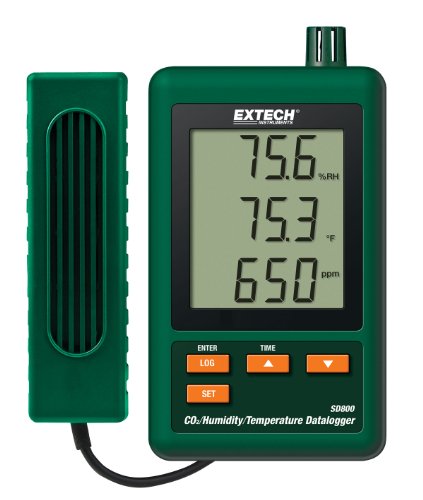
The SD800 data logger by Extech features a triple LCD that can display three parameters: temperature, relative humidity, and CO2. There are 7 data recording rates, including 5s, 10s, 30s, 1m, 2m, 5m, and 10m. Teach reading is stored in a 2GB SD card in the excel format with a time and date stamp. The unit features a maintenance-free dual wavelength CO2 sensor that can check for the concentrations of the substance in the air. This is useful to ensure air quality in public areas like hospitals, office buildings, and schools.
Technical features:
- Record: 2GB
- Humidity range: 10% to 90%
- Temperature range: 00C to 500C
- Recording intervals: 5s, 10s, 30s, 1m, 2m, 5m, and 10m
- Triple LCD display
5. Elitech GSP-6 Temperature Data Logger Review
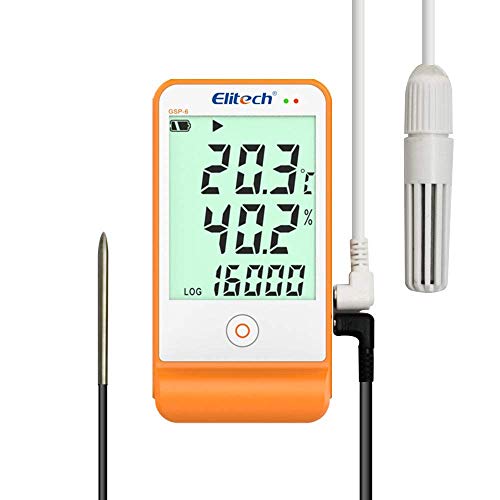
With extremely sensitive temperature and humidity sensor, the Elitech GSP-6 data logger would quickly obtain and record first-time readings obtain for many applications. It is designed with a 2.8-inch LCD display with large numbers to allows you to see the results clearly. With the recording interval ranging from 10 seconds to 24 hours, it is simple to choose your needed option. There will be both visual and audible alarm in case of over limit. This data logger can record up to 16,000 readings which are available in txt, pdf, excel, and word format.
Technical features:
- Data format: txt, pdf, excel, word
- Record: 16,000 readings
- Temperature range: -400C to 850C
- Recording interval: 10 seconds to 24 hours

